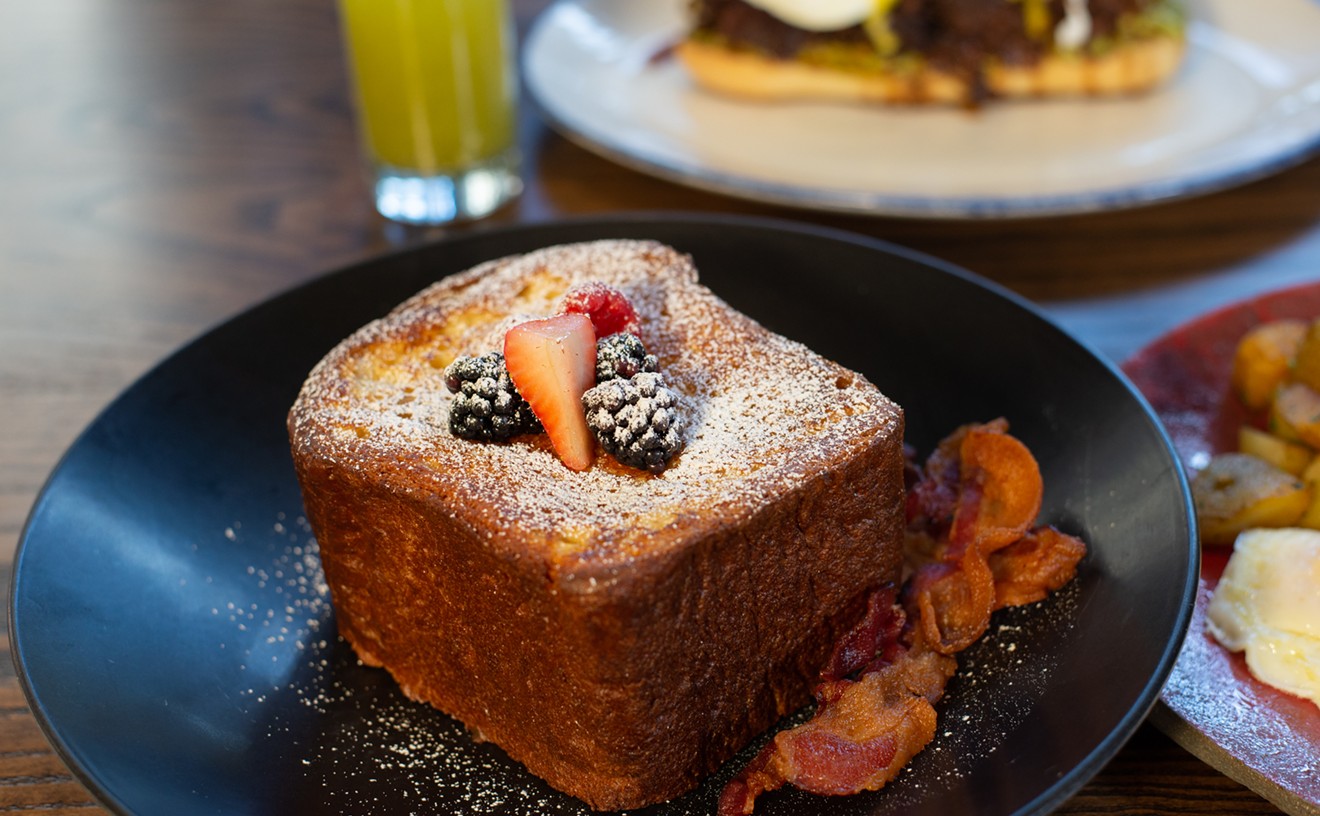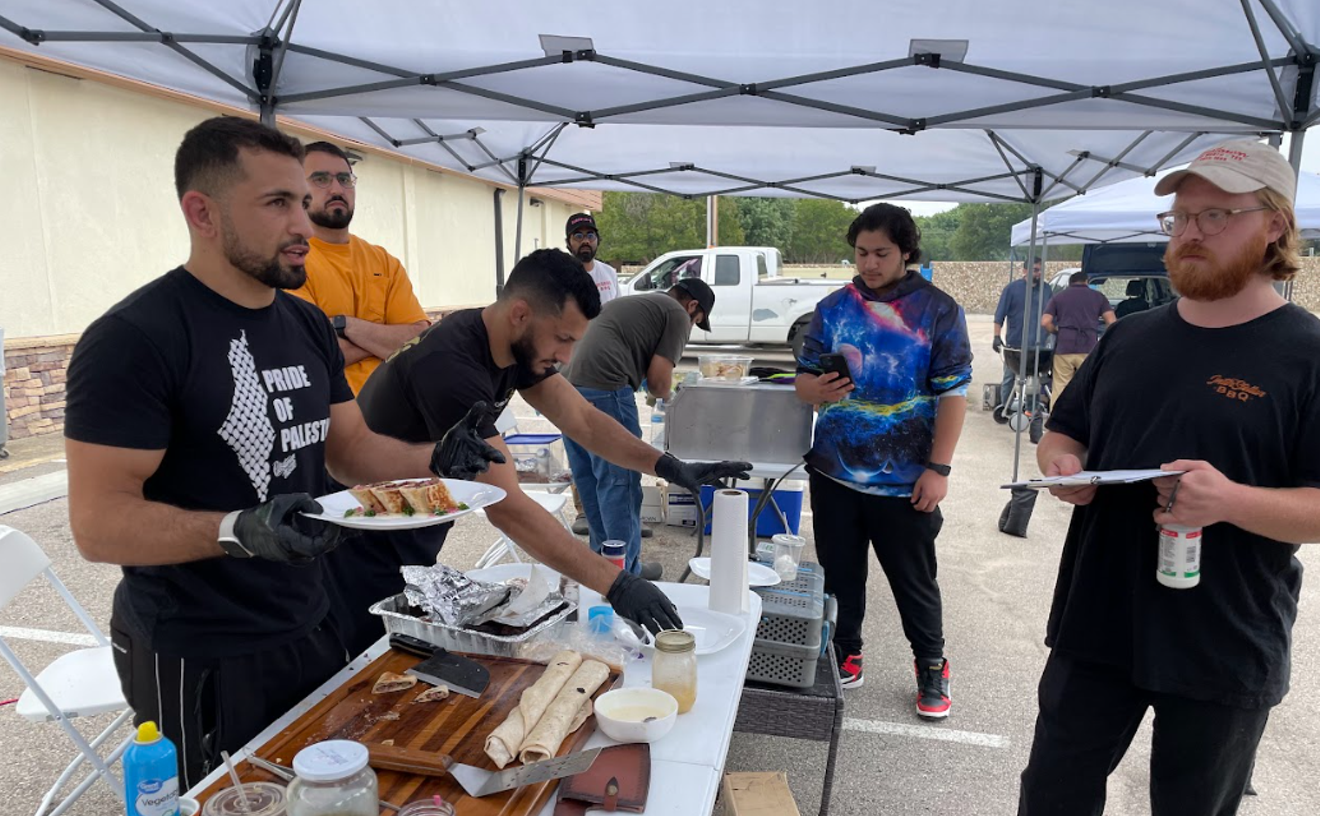Apheleia, the group also behind El Bolero and Pakpao Thai, had big plans. With Tesar as consulting chef, the restaurant group saw two big openings in 2016, the Royale Magnificent Burgers in Plano in February and upscale cocktail lounge Quill next door to Oak in March. Tesar was a public face for both.
But by April, a little after a year with Apheleia, Tesar was out. He left the restaurant group and the projects he'd helped launch for their brand.
“It’s hard to explain why a 58-year-old man would walk away from four restaurants,” Tesar told the Observer in June. “I learned a lesson. It was great to start out with Richard [Ellman] and try to do all this stuff, but it was a mistake for me, because I really need to focus on what I do, not just have 10 restaurants.”
Suddenly, Tesar’s many irons in the fire became one (plus a cookbook, Knife: How to Bring the Steak House to Your Home, which Tesar says he wants to release next year), and he found himself contemplating what was next. Now, he finds himself more wary of inking deals with business groups with grand plans and cautious about the exploding Dallas dining landscape.
“Oh, there’s a bubble,” Tesar says, likening the current state of Dallas dining to Russian roulette.
“I think that’s a real estate game that Dallas is revealing itself to, in the sense that they’re using restaurants and bars to gentrify neighborhoods; but at the end of the day, I don’t see any long-term future in that,” Tesar said in his June interview with the Observer. “I think Dallas is building a bubble, and I don’t want to be the guy with 10 restaurants when the bubble bursts.”
In the last three decades, the culture surrounding food has changed. Chefs are getting book deals, TV shows and, locally, are being courted by developers hoping to capitalize on a trending personality. Media outlets covering food have exploded into a landscape filled with diners suddenly hungry for food news, recipes and details about every new restaurant. Even in Dallas, certain chefs have become household names.
And why wouldn't they be? According to data from a 2015 Bureau of Labor Statistics’ Consumer Expenditure Survey, diners in DFW spend more money at bars and restaurants than diners in any city in the U.S. Dallasites go out 70 percent more often than the national average, according to data from the Greater Dallas Restaurant Association, and they spend 12 percent more than the average diner when they do go out. The association is predicting that the industry will grow by 22 percent in the next decade.
"The city has seen an increase in food establishments over the past few years," says Matt Cloninger, sanitarian supervisor with the city's Department of Code Compliance. Dallas has about 6,300 permitted fixed food establishments, according to city data, and 800 mobile food units.
As those numbers increase, the influx of establishments is making some restaurateurs back off.
"It's a subject we talk about every day — [Dallas] is way over-restauranted," says Shannon Wynne, who with his business partners has opened successful concepts like Meddlesome Moth, Flying Saucer Draught Emporium and Rodeo Goat.
On top of growth in the local dining scene, it's more expensive than ever to run a restaurant, Wynne says, not just because of inflation but because both kitchen talent and real estate have become pricey.
"Chefs are commanding higher than usual fees and landlords are charging more rent than most restaurants have the capacity to pay," Wynne says. "There will be an explosion just like always. There will be a pop and we'll all remember the old days when it's happened before."
—
Part of Dallas' growth in the dining industry can be explained by real estate trends — particularly in mixed-use developments. Developers, in attempting to target the millennial demographic, are building developments where residents can live, work and play, rather than building stand-alone residences, office buildings and retail.
This is particularly important to the 18- to 34-year-old crowd, which is more likely to rely on alternative transportation like biking and walking than buying cars. Both car and home ownership are less important to a generation that spends a larger percentage of its income on technology and "experiential" things, like food and going out. In 2010, The Atlantic reported, "adults between the ages of 21 and 34 bought just 27 percent of all new vehicles sold in America, down from the peak of 38 percent in 1985." Millennials, who came into adulthood during a recession, make less money than previous generations and tend to be saddled with more debt.
They're also attracted to cities and urban areas. Millennials' propensity to rent rather than own, to use alternative transportation and to spend discretionary money on experiences rather than things makes them particularly drawn to the mixed-use development. More than three-fourths of millennials (78 percent) would rather spend money on an experience or event rather than a physical item, Forbes reports. And dining — particularly with the rise in popularity of chef-driven experiences and craft beer, which millennials spend far more on than previous generations — is a major part of that discretionary spending.
As this age bracket becomes one of the country's biggest spending groups, there are more and more developments catering to a population for whom eating out is a regular indulgence. In Dallas mixed-use developments, restaurants are frequently anchor tenants.
"It used to be a restaurant element was 20 to 30 percent [of a development]," says Frank Mihalopoulos, owner of Corinth Properties, the development group behind Glen Oaks Crossing in Oak Cliff and Eldorado Plaza in McKinney. "In some cases today, it's 60 percent."
Along with anchoring developments, restaurants have increasingly taken on another role that has nothing to do with food: changing neighborhood dynamics.
"The Uptown area and the restaurants and entertainment — that has turned that around," Mihalopoulos says, noting that restaurants give a neighborhood business "at different hours." "Restaurants are our entertainment. We don't have the lakes, the oceans, the rivers; we have restaurants."
Dallas businessman Phil Romano, the man behind Fuddruckers and Eatzi's and the Trinity Groves development in West Dallas, built the latter, a "restaurant theme park" in an underdeveloped part of Dallas. As he developed Trinity Groves, he kept a particular group of consumers in mind.
"This new market out there, the millennials," Romano says, "they want new and different things. I call them 'new people.' They just want different things."
Trinity Groves is scheduled to have 20 restaurants operating by the end of the year, Romano says. His approach when building the development — where apartment buildings across the street are under construction — was to draw consumers out first with entertainment.
"We built amenities first, and then are putting the community in," Romano says. "Usually you put the community in first and the amenities in next."
Trinity Groves is not a typical mixed-use development. For the dining component, Romano says his team interviewed more than 500 restaurant applicants — "We did like a Shark Tank" — and selected concepts based on what Romano thought might be able to expand down the road. The development's entrepreneurial fund of "$12 or $13 million" helped foot the bill for incoming restaurants that were selected, Romano says.
"We tell the young kids, OK, we'll put up the $500,000 into your concept," he says. "If we do that, we will own 50 percent of it."
To make it in Trinity Groves, a business has to prove itself, Romano says.
"You gotta do at least 2 million in sales, gotta be owner-operated, gotta fit this millennial trend that's coming in there — and there's no guarantees on the lease," he says.
Romano recently ousted the "permanent pop-up" restaurant Kitchen LTO, which closed abruptly in July. The concept's owner is seeking donations to help move the restaurant to a new space in Deep Ellum.
"It's funny — we thought that was gonna be good," Romano says. "It worked in the beginning then it just wasn't doing the business. It was losing money."
Despite a few closures since the first Trinity Groves businesses opened in 2012, Romano thinks the concept works and is planning to try the development in other cities, potentially in DFW suburbs, he says. Romano doesn't buy into the idea that Dallas is over-restauranted.
"Listen, how fast is Dallas growing?" Romano says. "The Metroplex is growing faster than anyplace in the United States. People are always going out. Who goes home for lunch? And at night time, everybody goes out." Or if they don't go out, they bring prepared meals in. "That's why Eatzi's is going so well — because people don't cook anymore, " he says.
"They need restaurants," Romano says. "I don't think we've met the demand yet."
—
When chef Graham Dodds brought his Southern-inspired, vegetable-centric concept Wayward Sons to Lower Greenville late last year, he knew it was a risk.
"We opened this and there’s obviously so many restaurants to choose from, you really have to be competitive with your pricing," Dodds says. "That’s hard, because I feel like I use nicer, better, more expensive ingredients than a lot of people, but we still have to compete with those price points."
It doesn't help that Dallas' restaurant scene has only grown more competitive in recent years, Dodds says.
"I think everybody wants to open places, and it’s strange to me since it’s so saturated," he says.
Despite that, Dodds is developing the menu for a new concept: Ferris Wheeler's Backyard & BBQ, a barbecue restaurant planned for the edge of the Design District. Along with a 7,000-square-foot patio, the restaurant will have an outdoor stage and a 50-foot Ferris wheel. It's certainly not a small venture.
"I thought it was a fun challenge," Dodds says of the new concept, slated to open in the next few months.
But the biggest challenge in the coming days may have nothing to do with the menu. Staffing, Dodds says, hasn't been easy recently.
"Hiring is an issue," Dodds says.
The restaurant industry has always had notoriously high turnover. While Dodds says he's got a good core team in the kitchen, he's had a hard time hiring for positions like dishwasher. To help keep his kitchen staffed — and diverse, which Dodds said can be a challenge — he's partnered with an organization that helps house and find employment for refugees from countries such as Iraq and Syria.
"These guys have never cooked before," Dodds says. "This organization helps them with housing, helps place them in a job. There are a lot of people who don't work out, but when they do, it makes it a really diverse group here."
Local restaurateurs who are expanding their concepts are feeling particularly frustrated by staffing woes.
"It’s definitely been stressful hiring," says Jay Jerrier, owner of Cane Rosso, Zoli's and Cow Tipping Creamery. "Every time we open a new restaurant, it's impossible to find people."
Part of the problem is the nature of the industry itself, and Jerrier knows that. "It's a crazy lifestyle," he says. But Jerrier also doesn't hide his scorn for the classic millennial stereotype, who have been subject of many a trend story wondering how to manage this finicky population properly.
"The servers are all like, 'Dude, Burning Man lineup came out. I need to take off this week,'" he says. "'This place isn't chill enough to work at.' I don't get it. It's like nobody wants to work."
With so many other restaurants in the city, Jerrier says, he's had employees walk out in the middle of a shift because "they can walk down the street and get another job." There are too many restaurants, he says, and too little talent.
"At some point there's only so many people," he says.
Saturation and hiring issues in the Dallas industry was part of Jerrier's impetus to expand Cane Rosso in other cities, opening two locations in Houston and one in Austin this year.
"We kind of wanted to get outside Dallas just to insulate ourselves a little bit," he says.
According to data from the Greater Dallas Restaurant Association, the Dallas restaurant industry employs more than 283,000 people, which the association says makes up 25 percent of the Texas restaurant industry. Even still, as the industry grows, the advocacy organization knows that hiring has become an issue for restaurants.
"If you look at this though from across industries where there are service-related needs, you'll find that the construction industry is facing the exact same issue right now and we still have cranes up in the air," says Andy Rittler, executive director of the Greater Dallas Restaurant Association. "When you have economic development opportunity like you do in the state of Texas, you're going to face these issues."
To combat hiring issues in the industry, the Texas Restaurant Association participates in the Texas ProStart Program, the state arm of a national program created to prepare students for a potential career in the food industry. The program targets high school students who may be curious about working in service, management, operations or marketing.
"We provide scholarship programs to make this a long-term career option for them," Rittler says. "It's in about 60 schools currently in the DFW area."
Carina Vasquez transferred to Skyline High School, a Dallas ISD magnet school with a culinary arts program, early in high school. Her freshman and sophomore years were challenging, she says, as she got accustomed to working in a kitchen under a chef. Her junior and senior year, she worked at Skyline's Raider Cafe, where the public can eat — moving to various stations in the kitchen. Skyline chefs like April Barney helped students make connections outside Skyline's kitchen.
"Chef Barney actually helped me get my first culinary job at HG Sply Co. with chef Danyele McPherson around my second year of college," Vasquez said. "Started in pantry and desserts, then saute, prep, to practically being lead line cook. I learned a lot and thanked the chefs for teaching me most things I learned there."
After a stint at HG Sply, Vasquez got a job under pastry chef Marlene Duke at The Theodore, which she recently left to focus full-time on college. Vasquez, a first-generation college student, is going to El Centro to study culinary arts and pastry. Before going back to school, she was working graveyard shifts, which has taught her about how demanding food service can be, she says.
"Working the graveyard shifts now have affected me a lot in sleeping and eating habits and my life's routine, but I still manage to spend time with my family and people I care about," Vasquez says. "I have gotten use to working long hours and I don't mind it, even though you do miss a lot of important family events and living the young life, but I want to prosper in the industry."
The Greater Dallas Restaurant Association has a scholarship program to help entice people like Vasquez into culinary arts. The goal, they say, is to introduce more trained professionals into an industry that needs it.
"We understand, just like a lot of trade associations out there, that we can either complain about the problem or initiate a solution," Rittler says. "The economic drivers behind the industry are incredible — and so are the opportunities."
—
For chef Tim Byres, there were times when he was sure his West Dallas restaurant Smoke was done for.
"We had a New Year's Eve when we didn't think we were gonna make it," Byres says. "We did a kind of baked Alaska that was on fire. That was kind of a joke of, like, the last dessert served on the Titanic." But Smoke pulled through, becoming a major part of the Dallas dining scene, and a location in Plano came after, as did Chicken Scratch nearby and late last year came The Theodore, a playful eatery in NorthPark Center. As Byres' profile grows, he gets more offers — but he's cautious.
"We got a lot of offers. It's a lot of opportunities and some really big ones," he says. "But I think that, like, today ... I'm at The Theodore today and I'd like us to have a great lunch service."
Right now, he says, he just wants to be still for a minute.
"We grew really quick," he says. "Two, three years after Smoke opened, we opened Chicken Scratch at The Foundry — another sweat-it-out, make-it-work situation — then Smoke Plano and in under a year, really, The Theodore kind of happened. So it's just, like, so much."
The more successful concepts Byres opens, the more cautious he becomes.
"I've lost everything I've owned at one point," Byres said. "Now I would just wait – wait for the best thing because, like, I don't know. If it looks too good, it's too good."
Tesar, too, finds himself wary of the offers coming across his desk. He's lost too much, he says, to go jumping into a deal that isn't perfect. There's too much at stake if a project fails.
"You lose your momentum at the very least," he says. "In the interim you could lose your friends, family, everything you know to be yours."
Now, Tesar says he's expanding in a different direction. He's going smaller, not bigger. His next opening: Knife Burger, a quick-service burger counter inside the forthcoming Legacy Hall, a food hall coming to Plano. He was inspired, he says, "after watching the success of Ten Ramen," a 700-square-foot ramen shop in Sylvan Thirty. Tesar's new eatery will have a small menu with a couple of Knife's most popular burgers, "two employees and an iPad," he says. Its footprint — and overhead — will be far smaller than any of his past projects.
“That’s the way of the future," Tesar says. "It’s playing it safe 'til the bubble bursts.”











